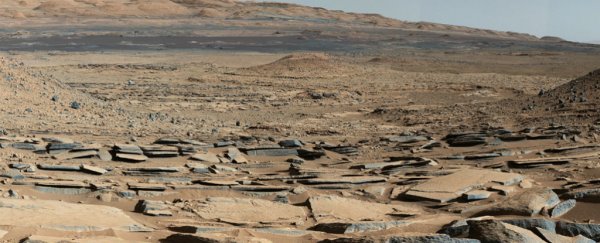The existence of water on Mars has been one of the most compelling mysteries in the history of human space exploration, and new clues are now being discovered on a regular basis. A new report published by NASA's Mars Science Laboratory team points to evidence that the surface of the planet was indeed covered by huge lakes several billion years ago - lakes that have since disappeared, possibly evaporating into the atmosphere and the deep space beyond.
The idea that large bodies of water covered the surface of Mars is not a new one, but looking so far back into the past with a great degree of accuracy is incredibly difficult - so any fresh piece of evidence is a useful addition to NASA's theories. This particular paper, published in the journal Science, uses data gathered from the Curiosity rover currently trundling across the surface of the Red Planet.
As Curiosity has explored the Gale Crater on Mars, it's found evidence of many layers of sediment - sediment that was left behind by lakes and now forms the base of Mount Sharp (or Aeolis Mons). The crater and the mountain at the centre of it are judged to be around 3.8 to 3.6 billion years old.
"What we thought we knew about water on Mars is constantly being put to the test," said Michael Meyer, one of NASA's lead scientists. "It's clear that the Mars of billions of years ago more closely resembled Earth than it does today. Our challenge is to figure out how this more clement Mars was even possible, and what happened to that wetter Mars."
While we've known about the sediments in the Gale Crater for some time, some scientists hypothesised that they were created by dust and sand blown by the wind. As Curiosity has looked closer, it seems that rivers and lakes were actually the cause - at least for the lower levels of Mount Sharp, which is as far as the rover has got. The finely laminated mudstones that Curiosity has discovered match the types of rocks that would be left behind by large bodies of water.
It's possible that those lakes expanded and contracted over hundreds of millions of years. What still puzzles scientists is where all this water came from in the first place.
"Paradoxically, where there is a mountain today there was once a basin, and it was sometimes filled with water," said John Grotzinger, the lead author of the new report. "We see evidence of about 250 feet (75 metres) of sedimentary fill, and based on mapping data from NASA's Mars Reconnaissance Orbiter and images from Curiosity's camera, it appears that the water-transported sedimentary deposition could have extended at least 500 to 650 feet (150 to 200 metres) above the crater floor."
